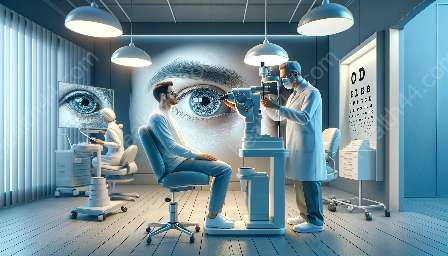Dry eye syndrome is a common condition that occurs when the eyes don't produce enough tears or the tears evaporate too quickly. It can cause discomfort and affect vision. In this guide, we'll explore the evaluation and treatment guidelines for dry eye, along with relevant eye care techniques, procedures, and vision care.
Evaluation of Dry Eye
Diagnosing dry eye involves a comprehensive evaluation of the patient's symptoms, medical history, and ocular surface. The following key factors are considered:
- Symptom Assessment: Patients are asked about their symptoms, including dryness, scratchiness, burning, and foreign body sensation.
- Tear Production Analysis: The quantity and quality of tears are evaluated through various tests, such as Schirmer's test, tear breakup time, and tear osmolarity measurement.
- Ocular Surface Examination: A thorough examination of the ocular surface is conducted to identify any damage, inflammation, or irregularities.
- Additional Testing: In some cases, advanced diagnostic tools like ocular surface imaging and meibography may be used to assess the condition of the meibomian glands and the overall health of the ocular surface.
Treatment Guidelines
Once dry eye is diagnosed, a multifaceted treatment approach is often necessary to manage the condition effectively. The treatment guidelines may include the following components:
- Lifestyle Modifications: Patients are advised on environmental and behavioral changes, such as using humidifiers, avoiding irritants, and taking regular breaks during prolonged screen time, to minimize dry eye symptoms.
- Artificial Tears: Lubricating eye drops can provide symptomatic relief by supplementing natural tears and improving ocular surface hydration.
- Medications: Prescription eye drops, such as anti-inflammatory agents or medications that stimulate tear production, may be recommended to address specific underlying causes of dry eye.
- Meibomian Gland Dysfunction Management: Therapies aimed at improving the function of the meibomian glands, like warm compresses, eyelid hygiene, and meibomian gland expression, are crucial for managing evaporative dry eye.
- Contact Lens Care: Patients who wear contact lenses need to follow specific care regimens and may benefit from using specialized contact lens solutions to alleviate dry eye symptoms.
- In-Office Procedures: Advanced procedures, such as punctal plugs insertion, intense pulsed light therapy, or scleral contact lenses fitting, may be recommended for patients with severe or refractory dry eye.
Eye Care Techniques and Procedures
Eye care techniques and procedures play a vital role in managing dry eye and promoting overall ocular health. Some of the techniques and procedures commonly utilized include:
- Blinking Exercises: Encouraging frequent blinking can help distribute natural tears and prevent ocular surface dryness.
- Ocular Hygiene: Educating patients about proper eyelid hygiene and warm compress techniques can improve meibomian gland function and reduce tear film instability.
- Nutritional Supplements: Omega-3 fatty acids and other supplements can support ocular surface health and improve tear quality.
- Therapeutic Contact Lenses: Scleral or bandage contact lenses are used to protect the ocular surface, provide continuous lubrication, and improve visual comfort for patients with severe dry eye.
- Low-Level Light Therapy: Devices that emit low-level light can stimulate meibomian gland function and reduce inflammation on the ocular surface.
Vision Care
Effective vision care goes hand in hand with managing dry eye, as compromised ocular health can impact visual acuity and overall comfort. Vision care strategies for individuals with dry eye may include:
- Regular Eye Exams: Routine eye examinations are crucial for monitoring the progression of dry eye, addressing changes in visual needs, and adjusting treatment plans accordingly.
- Corrective Lenses Management: Optometrists and ophthalmologists work with patients to ensure that their corrective lenses, whether glasses or contact lenses, are suitable for their changing visual requirements due to dry eye.
- Visual Ergonomics: Educating patients about proper visual ergonomics, including proper lighting, screen positioning, and ergonomic workstations, can help alleviate visual strain associated with dry eye.
By combining targeted evaluation and treatment guidelines with specialized eye care techniques and procedures, individuals can effectively manage dry eye and preserve their vision and ocular comfort. It's essential for patients to work closely with their eye care professionals to develop customized strategies that address their specific dry eye symptoms and overall visual needs.



